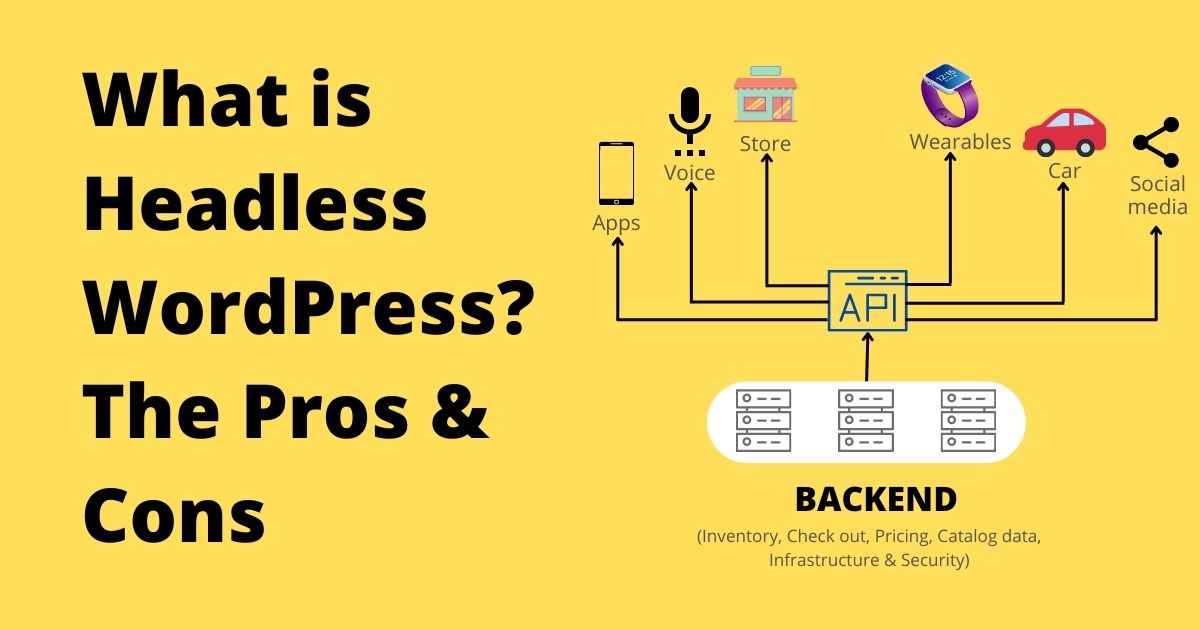WordPress is the most popular CMS (content management system) platform. This open-source platform is used for creating blogs, business websites, and even eCommerce stores. At present, there are over 455 million WordPress websites out of a total of 1.3 billion websites across the internet.
Plugins make WordPress easy and simple to use. Using different plugins, you can add customization and your desired functionality to the website.
However, the problem with traditional CMS is front-end and the backend of the website are connected. This not only limits flexibility but also becomes a hurdle when trying to scale.
This is when headless CMS comes in. Headless CMS basically means a content management system that uses a decoupled architecture. It separates the website’s front-end from its backend. Going headless with WordPress can help you improve your website’s user experience even more.
What is Headless WordPress?
Headless WordPress means a website that uses WordPress for managing content and a custom frontend stack to display that content. How headless WordPress is different from conventional WordPress?
Unlike conventional WordPress, headless WordPress has a backend separate from the website’s frontend. Any changes in the frontend don’t affect the backend. For the communication between the frontend and backend, APIs (application programming interfaces) are used.
Though going headless will demand advanced programming and more maintenance, considering the advantages, it’s worth the time & money spent.
Now that you know how headless WordPress is different from standard WordPress, let’s check out its pros and cons.
Pros of Headless WordPress
Here are some advantages of going headless with WordPress:
Multichannel
Today, users are spread across various channels. Headless WordPress lets you deliver content across multiple channels like websites, apps, smartwatches, TV, AR/VR, etc. Using an API like REST API, you can easily distribute content on various channels.
Developer-friendly
Going headless will make your WordPress website developer-friendly. In standard WordPress, PHP, HTML, CSS, and JavaScript are the available languages. But, what if you want to try new languages and frameworks not compatible with PHP? In that case, going headless is the solution.
Performance
After switching from traditional to headless WordPress, you will notice a significant improvement in performance. Traditional WordPress websites take too long to load because, in the backend, they go through the entire process: starting from loading wp-config.php to connecting to the server.
Slow loading can frustrate your visitors and make them leave the website without taking any action. With headless WordPress, only important files will be loading through API calls. As a result, your website will load much faster.
Security
Security is another reason why companies nowadays have started switching to headless WordPress. Going headless is like adding an extra layer of security to the website. It can save your website from attacks like DDoS. No matter whatever security plugin you use or what security measures you take, the standard WordPress website cannot be as secure as headless.
Scalability
In terms of scalability, going headless can benefit a lot. Redesigning the website or making any technical changes to your website won’t lead to downtime. Thanks to APIs, you can easily integrate any technology or framework which can help your business scale.
Cons of Headless WordPress
While there are many advantages of using headless WordPress, there are some disadvantages as well.
WordPress functionality disabled
This is the main concern for most developers who switch to headless from traditional WordPress. By going headless with WordPress, you will lose access to many features and functionalities; for example, the WYSIWYG editor and the live preview. Besides this, using plugins would also be a problem as the majority of WordPress plugins would stop working.
Not for non-technical
It is so easy to build beautiful websites with conventional WordPress using plugins and pre-built themes. However, creating a headless WordPress website isn’t that easy. Most plugins don’t work with headless WordPress. For people with zero development knowledge, there’s no drag & drop functionality or plugins to help with the web development process.
More maintenance
As frontend and backend are separated in headless WordPress, you have to manage both separately. As a result, more time, money, and resources will be required.
Final Thoughts
Going headless with WordPress provides great room for flexibility. Though it is quite expensive (compared to traditional WordPress), in terms of performance, security, and scalability, it beats traditional WordPress.
Note that going headless may not be the right choice for all WordPress websites. For example, if you have a small business website or a blog, then going headless may not be a good idea. On the other hand, if you have a big enterprise looking for a multichannel solution, you should go headless with your WordPress website.
If you are planning to create a headless WordPress website or move from traditional to headless WordPress, we can help you. For any query, feel free to get in touch with us at support@encircletechnologies.com
Also Read:
